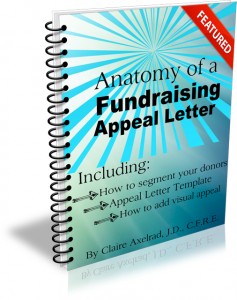The end of the year will be here before you know it!
Working on your year-end appeal?
Wish you had a way to prioritize the stuff that really matters?
Around this time of year, it’s common for me to hear one or more of the following — not just from newbies to the profession, but also from seasoned pros:
I’m struggling with copy. Last year’s appeal didn’t do as well as hoped.
I think our copy is okay, but wish it could be more inspiring.
I wish I knew some tricks to get more folks to open our envelope (or email).
I’d like to leverage our appeal with some email and social media, but don’t know where to start.
I’m flying by the seat of my pants! Wish I knew what to do and when to do it better.
If these statements sound familiar, don’t worry. You’re not alone.
Crafting fundraising appeals and end-of-year campaigns is not rocket science, but you do have to adhere to certain guidelines if you want to achieve blast-off. So… here come some guidelines!
I’m putting these in order, with the most important at the top. There are plenty more tips where these came from however, so since I’ve only selected six, you can consider all of these critically important to your success.
1. Mailing list, mailing list, mailing list.
You can have the best copy in the world, but without the right group of people to send it to you won’t raise much money. I can’t overemphasize this. I’ve seen too many fundraising campaigns fail for want of the proper list. When it comes to assuring fundraising success, apply the Pareto Rule. Spend 80% of your time building your list; 20% writing copy and designing your package. This holds true for both your email and your snail mail lists.
ACTION TIP – To build a good list begin with folks closest to you:
- Current donors
- Past donors
- Board and committee members and staff
- Event attendees
- Folks connected to you in other ways (e.g., volunteers, parents of students, alumni, families of patients, purchasers of programs, friends of board members and volunteers; subscribers to your newsletter etc.).
2. Get it opened.
Your letter is no good if the envelope gets tossed right away. I receive my mail in my garage. I stand over my recycling bin, trying to discern which pieces will go there immediately, and which will get carried upstairs into the house. What will get your reader to bring your letter inside?
I often read my email on my phone, in those stolen moments while I’m waiting for something else to happen. I hover over the delete button, trying to decide if it’s really worth saving this email for later when I’ll have more time or be at my desk. What will get your reader to hit “open?”
ACTION TIPS – Consider the following:
- Plain envelope. I’m a huge fan of the plain white envelope with nothing. No logo. Not even your name. Just a return address (and a place where a volunteer who is adding personal notes can hand write their own name). It’s hard for folks to simply toss a mysterious plain envelope. Note: the post office won’t allow this unless you’re using a first-class stamp, so it’s for renewal and warm prospecting letters more than for direct mail acquisition.
- Colored envelope. This is something to test. I’ve had great success with brightly colored envelopes that don’t even match the design of the enclosed appeal. They simply stand out in the mail box and do their job of getting opened.
- Oversized envelope. This is another trick to get folks to take notice. An oversized envelope stands out in the mail. Of course, it requires extra postage and this can backfire, making folks think you’re using money for the wrong purposes. It works best for event invitations rather than annual appeals.
- Envelope teaser. Direct mail fundraising guru Mal Warwick describes a range of needs that can be accomplished with a teaser, ranging from describing what’s inside to asking a question to starting a story. He also says “Often the best teaser is no teaser at all. Fundraising letters are almost always crafted to mimic personal letters, so teasers may well cheapen or undermine the effect the writer wants to achieve.” Use some judgment. And ask folks outside your office if the teaser would turn them on or off. Begin your own collection at home, noting which teasers get you to open the envelopes and which you’d be inclined to toss.
- Subject line teaser. The subject line is like the outer envelope for direct mail. It’s the window into your message. Make it intriguing, urgent, exciting, compelling, emotional, shocking or funny. The more useful and specific it is the better. Read more on some great year-end email subject lines.
3. Begin with the P.S.
I don’t seem to be able to say this enough! I’m astounded by how many nonprofits ignore this valuable piece of real estate. Folks, please listen up: it’s the ‘Board Walk’ and ‘Park Place’ of your letter! 90% read the P.S. first.
ACTION TIP – Write your letter; then take a good look at it and pull out your most important message and move it to the P.S. to assure it’s seen.
4. Ask more than once.
Don’t wait until the end of the letter to get to the point. This is the entire purpose of your appeal! Find both “soft” and “hard” ways to call for the action you want, and sprinkle them throughout your appeal. Remember: people skim. To assure they see the point of your mailing, repetition is a good thing.
- “You make it possible.”
- “This work completely depends on you.”
- “Can’t do it without you…”
- “Take this step…”
- “Please join me…”
- “Make your gift right now.”
5. Make it reader-centric.
Never forget your primary job: to invite the reader to join you in something amazing… essential… critical… inspiring… ultimately fulfilling and joyful. Don’t make it about you. Make it about their experience.
ACTION TIPS:
- Use “you” rather than “I” or “we” or “[name of your nonprofit]
- Cross out all the ego-centric stuff and rewrite.
As veteran communicator Tom Ahern says:
“You” is glue. Every time you use it (especially in headlines) the reader pays slightly more attention…involuntarily. It’s the best cheap trick I know.”
6. Make it readable.
The main point is this: don’t hurt your readers’ eyes or get their brains twisted in a knot! They don’t have time to bother with that, so they won’t have time to bother with you. All your brilliant copywriting will go to waste.
ACTION TIPS:
- Use a serif font. It’s more readable.
- Bump up the size of your font. It used to be 12 point minimum. Due to the aging of baby boomers, today it’s 14. Resist the temptation to eschew editing in favor of squishing your font down to 11 point so you can fit everything in. Less is definitely more here.
- Indent paragraphs. Not only is this a friendlier style (something I learned in middle school typing class), it also invites the readers into your copy and gives their eyes another little rest. Our brains use indents in “pattern recognition.” Pattern recognition is important to keep reading speedy. And, remember, your reader has no time.
- Keep paragraphs short. Aim for no more than five lines. Break them up with one-liners.
- Use subheads, boldface, italics and underline to emphasize key points. Don’t overdo it, of course. I like to consider my letters several letters within one letter. If the reader reads only the subheads, they’ll get the gist. If they read only the boldface, they’ll get the gist. And so forth. You don’t really know which part of the letter your donor will actually read, so repetition is essential.
7. Write like you — and your readers — talk.
ACTION TIPS:
- Read it out loud. Every place you’re tempted to put in a contraction, do so. If you want to begin a sentence with “and” or “but” go right ahead. If you want to have a one-word sentence, that’s just fine. If your spell check tells you you’ve got a sentence fragment you should ‘consider revising” ignore it.
- Go back to middle school. There’s something called the Flesh-Kincaid score (a built-in tool in Microsoft Word will tell you if your writing is above a 7th-grade level. You don’t want it to be. Jeff Brooks, in The Fundraiser’s Guide to Irresistible Communications, suggests you’re better off in the 4th – 6th grade range. Short sentences. Short words. Help Jane run. Give Dick food. Save a tree. Build a well.
- Avoid jargon. It’s the opposite of donor-centered writing. This includes words you use in your “trade” like “client” and “caseworker.” Lay people don’t use these words, or like to think of themselves as “clients” and their predicaments as “cases.” The same holds true for such ubiquitously overused words as “underserved” and acronyms.
Use these tips to give your year-end fundraising a shot in the arm! For more tips, check out the Year-End Fundraising Solution Kit.
Want More to Guarantee Your Appeal Raises More Money?

This 62-page e-Guide is a surprisingly quick read — and a true road map to creating a winning fundraising appeal
Get my Anatomy of a Fundraising Appeal + Sample Template — a thorough e-Guide with everything you need to put together an offer your prospect can’t possibly refuse!
This is super practical stuff I’ve learned over the past 30+ years. Plus I’ll explain to you why I’m suggesting you take the recommended actions — so if anyone tries to dissuade you from doing what you know works, you’ll have the ammunition you need to stick to your guns. That’s how you’ll raise more money.
Grab it here! I guarantee you’ll raise way more than the modest cost of this Guide — or I’ll make a donation to your nonprofit!
This article is an updated version of another that appeared 8-17-15 on Clairification.
-
Pingback: An Annual Appeal Fundraising Timeline You Can Use
-
Pingback: You Should Always Include This Element in Your Appeal - Qgiv Blog






